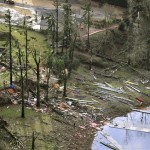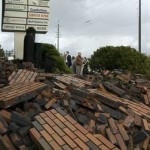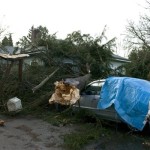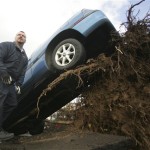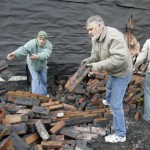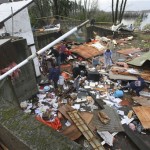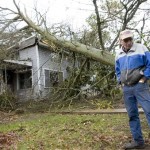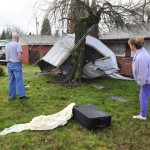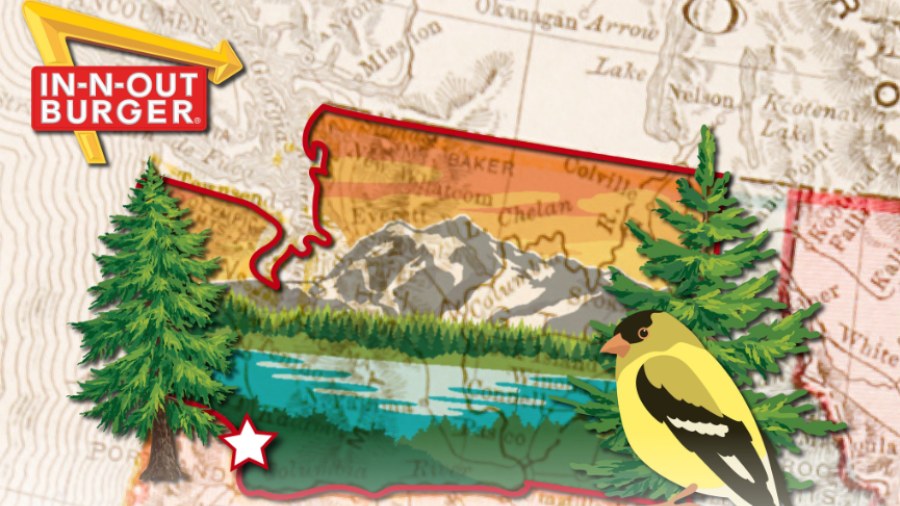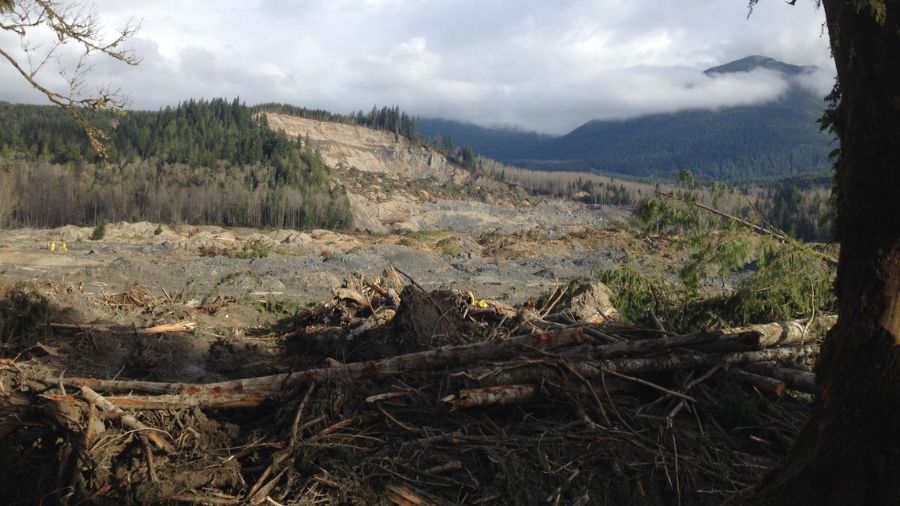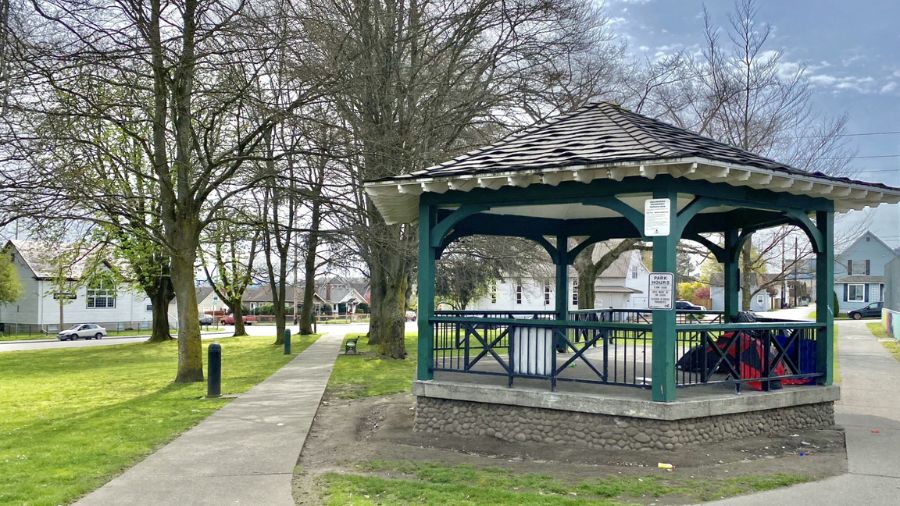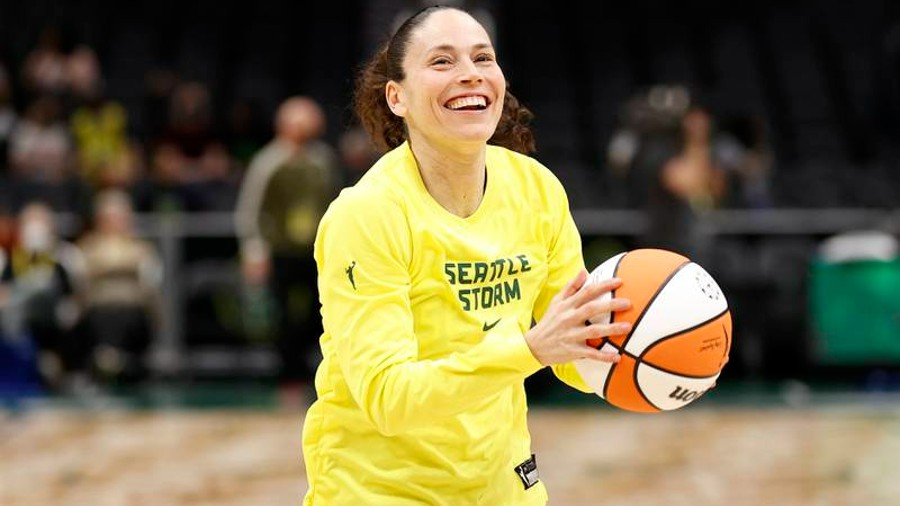1972 Vancouver tornado deadliest of Washington state’s twisters
Apr 5, 2017, 6:35 AM | Updated: Mar 27, 2023, 1:15 pm

The Johnson family has held onto this memento of the 1972 Vancouver tornado for 45 years. Curtis Johnson survived the destruction of the school shown in the photo. (Courtesy Curtis Johnson)
(Courtesy Curtis Johnson)
This week marks the 45th anniversary of a devastating tornado that struck Vancouver, Wash. on April 5, 1972.
RELATED: Seattle’s first Pearl Harbor Day
Tornadoes are rare but not unheard of in the Evergreen State, and they can sometimes be deadly. The twister killed six people that day in Vancouver 45 years ago – five in and around a discount store by falling debris, and one at a nearby bowling alley.
Ted Buehner is the Warning Coordination Meteorologist for the National Weather Service in Seattle. He was a high school student living in Portland 45 years ago, but he was already headed toward a career in meteorology. He remembers the severe weather that spawned the deadly tornado, since it began on the south side of the Columbia River and then moved north.
“It’s hard to believe, but Washington state actually led the nation in tornado deaths in 1972” because of the April 5 storm, Buehner said from his offices at NOAA last week. April is typically the most active month for severe weather – thunderstorms – in the Pacific Northwest.
The Vancouver tornado was also blamed for injuring about 300 people, with 54 of those requiring hospitalization. Property damage was estimated at $6 million in 1972 (or roughly $35 million in 2017).
Buehner says that the intensity of tornadoes is described using something called the “Enhanced Fujita Scale.” He says the 1972 Vancouver tornado was an EF3, which can be far more destructive than just about any other Northwest weather.
“EF0 is the weakest, so it has wind speeds maybe up to around 70 mph or so; EF1 will take you up around 110; EF2 will get you up close to 130,” Buehner said. “EF3 gets you up to 150.”
The destruction from the weather that day wasn’t limited to Vancouver. The storm or “squall line” that began in Portland continued well north and east of Clark County, with 87 mph winds recorded atop a building in downtown Seattle, and funnel clouds sighted west of Spokane.
With Buehner’s help, KIRO Radio tracked down three people who survived the April 5, 1972 tornado. Here’s the story of what they saw that day in their own words.
Beverly Johnson: He’s gotta be here someplace
Beverly Johnson is a mother of two. When the tornado struck just after 1 p.m., she was home with her kindergartener daughter. Her son Curtis was seven years old. He was in class at Peter S. Ogden Grade School a few miles away.
“I remember it vividly like it just happened. I was at home. At that time, we were living on the Royal Oaks Golf Course so I was watching this storm coming down the sixth fairway and then I heard that there was a tornado so I just dropped what I was doing and got in the car.
I was gonna go down to the school and found that I could not get anywhere near it, so I started walking. And then, in my anxiety, I was running through an open field and they were yelling at me: ‘Don’t run in there, don’t walk!’ because there was downed powerlines.
Anyway, I made it to the school but we couldn’t find Curt. And they said, ‘Go look in the gym, ’cause that’s where we’re sending the injured children,’ and he wasn’t in there. I just kept looking, [saying to myself] ‘He’s gotta be here someplace.”
Kevin Wood: Little hands sticking out from piles of brick
Kevin Wood was a 17-year-old junior at Fort Vancouver High School, right next door to Peter S. Ogden Grade School.
“I was actually with another classmate sitting on the east side of the school by the gymnasium. We were sitting on a stairwell balcony kind of thing. I just remember the weather being kind of weird and all of sudden it just got kinda quiet and still, where it almost felt like the hairs on the back of your neck were standing up. And then all of a sudden it just got really dark and the size of the hail that was coming down [was huge].
We were looking straight east from the [high] school right at Peter S. Ogden [Grade School] and it was . . . surreal is what it was . . . just kind of looking at it, and all of a sudden it looked like the entire school kind of lifted up into the air and just kind of imploded into itself.
We were one of several of the first ones over there. We just kind of ran across the field, which was probably about 200 yards away.
Some of the things that still really stick in my mind was seeing a kid’s jacket wrapped around a basketball hoop. And then just a pile of brick and rubble, and everything all over the place, and going through and looking and just seeing little hands sticking out from piles of brick and everything, and then just going through with other students and just pulling kids out from under this stuff.”
Curtis Johnson: The whole top of our classroom was blown off
Curtis Johnson is Beverly Johnson’s son. He was a student at Ogden School.
“I remember sitting in class. We actually had a view out to the south. And all of a sudden it just got really dark. And then there was some cabbage crates that were down on a field and all of sudden, you looked out there and it was all just was gone.
It went dark, and there was this incredible noise from the hail hitting the side of the school. There was kind of a glass front window area that looked out to the south. Then we just ducked.
And I don’t know if the teacher said ‘Duck!’ or [if she] really knew what was going on, but I remember getting under my desk. And in a blink of an eye, coming out from underneath my desk, the roof was gone . . . the whole top of our classroom was blown off.
Everybody was kind of running around. But for some reason, I decided [since] we didn’t live that far away, I decided I was gonna go home. So I started walking towards home.
By the time I got to a major intersection, there was a gentleman that stopped and looked at me and I guess at that point I had a big cut on my forehead or the top of my head, and I was bleeding pretty badly. He told me to get in the car and he took me up to the hospital.”
Searching for Curtis
Since he’d left Peter S. Ogden Grade School on foot and then been taken to a hospital by a Samaritan, Beverly Johnson was unable to locate her son. So she went back home. Her younger daughter was being looked after by a neighbor. Soon, her husband George arrived home from work to learn that Curt was missing. Somehow, through all the not knowing, the Johnsons remained calm.
Beverly Johnson: I knew he hadn’t been killed
“I mean, I knew he was alive. I knew he hadn’t been killed. He could’ve been wandering around the streets someplace or laying out in that field.
We just got in the car and decided we’d start checking hospitals. We went up to the main entrance — that was Memorial Hospital then — and said we were parents of a student from Ogden School. So they had made a list of people, the children they had brought in there, and he was on it, and we went and found him.
I was relieved to find his name on that list. Absolutely.”
Curtis Johnson: It’s OK, Mom and Dad are here
“I think my folks, once I found them and realized that they were OK, that just made a huge difference to me. I just really thought that maybe everybody was gone, or that I didn’t know what was left. I do remember when they finally found me at the hospital, then I settled down [and thought] ‘It’s OK. Mom and Dad are here.’”
Thunderstorm and tornado safety
The National Weather Service maintains helpful web resources to learn how to stay safe during thunderstorms (a far more common danger in the Pacific Northwest) as well as tornadoes.
Improvements to design and construction methods since 1972 mean that schools and other buildings nowadays fare better in severe weather. Vancouver’s Ogden School was so badly damaged, it was demolished and not rebuilt (it was replaced with a new school not far away). Incredibly, all the faculty and students who were there when the 1972 tornado struck survived the disaster.
Kevin Wood, the Fort Vancouver High School student who helped rescue elementary kids from the rubble, says that one other aspect of the disaster was handled differently than it would likely be today.
“I don’t remember talking to counselors or anything” in the wake of the tornado, Wood said. “There was a lot of discussion amongst ourselves, and getting to know students you didn’t know, because we’d all experienced the same thing.”
The tornado, rather than being only destructive, actually created a powerful bond that continues between Wood and some of his high school friends to this day.
You can hear Feliks every Wednesday and Friday morning on Seattle’s Morning News with Dave Ross and Colleen O’Brien, read more from him here, and subscribe to The Resident Historian Podcast here. If you have a story idea, please email Feliks here.
Follow @https://twitter.com/feliksbanel


